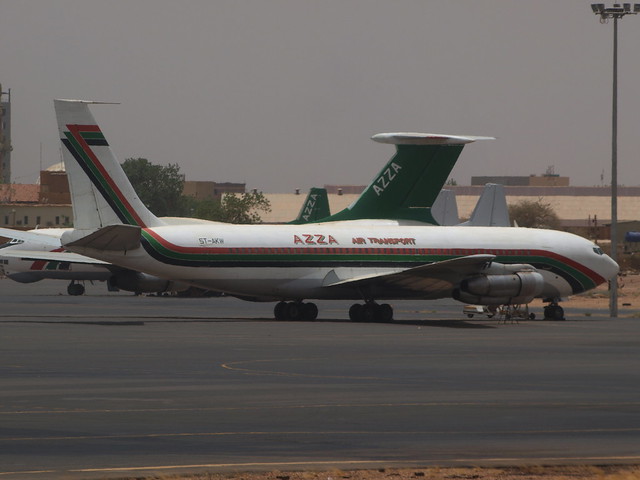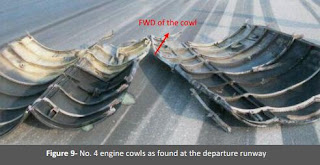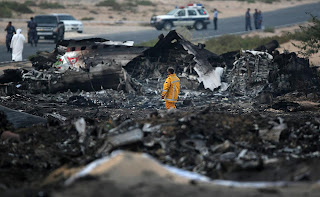 The UAE's General Civil Aviation Administration (GCAA) has released its final report on the 2009 crash of a Sudanese Boeing 707-330C (MSN 20123/788 | ST-AKW) operated by Azza Air (AZZ) on behalf of Sudan Airways(SD). The aircraft crashed into the desert outside Sharjah International Airport shortly after take off killing 3 passengers and 3 crew. The report blames a combination of poor aircraft maintenance, sloppy inspection standards on behalf of the Sudanese Civil Aviation Authority and inadequate crew training as the causes for the crash.
The UAE's General Civil Aviation Administration (GCAA) has released its final report on the 2009 crash of a Sudanese Boeing 707-330C (MSN 20123/788 | ST-AKW) operated by Azza Air (AZZ) on behalf of Sudan Airways(SD). The aircraft crashed into the desert outside Sharjah International Airport shortly after take off killing 3 passengers and 3 crew. The report blames a combination of poor aircraft maintenance, sloppy inspection standards on behalf of the Sudanese Civil Aviation Authority and inadequate crew training as the causes for the crash.Backround:
 |
| The Azza 707 in question (superspotty) |
On 21 October 2009, at 11h08L, the AZZA Air Transport Cargo Boeing 707-330C, operating as Sudan Airways SUD2241 to Khartoum, Sudan, with a cargo of air conditioning units, car parts, computers and tools on board, radioed Sharjah International Airport tower requesting engine start and pushback clearance from cargo area 60. A total of six persons were aboard the flight: three flight crew members (captain, co-pilot, and flight engineer), a ground engineer, and two load masters.
The tower controller cleared SUD2241 to start up and pushback for departure from runway 30. At about 11h29L, SUD2241 began its take off roll from runway 30 and proceeded to climb normally with no further communication with the tower controller.
However, approximately 15 seconds after liftoff, when the Aircraft was approximately 300 ft Above Ground Level (“AGL”), the core cowls of the No. 4 engine detached and fell onto the departure runway. SUD2241 then contacted the tower announcing that the Aircraft “was diverting back due to losing No. 4 engine”. Accordingly the tower controller pressed the "crash alarm" and simultaneously informed SUD2241 that both runways were available to land on.
The crew did not respond to the tower controller.
The Aircraft suddenly changed heading, banked and continuously rolled to the right at a high rate, sunk, and impacted the ground with an approximately 90° right wing down attitude. The impact was approximately 1.6 km (0.86 nautical miles) from the end of runway 30. All six souls on board were killed on impact.
There were no reported mechanical anomalies before departure. The high impact forces and subsequent fire completely destroyed the Aircraft.
Aftermath:
 |
| Engine #4 Cowl on the runway |
 |
| AZZA Air Transport 707 Crash in Sharjah (Reuters/GCAA) |
Investigation:
The subsequent investigation into the crash initiated by the GCAA revealed numerous safety shortcomings on the part of Sudan Airways, its MRO provider Egypt Company for Aircraft Maintenance, the Sudanese Civil Aviation Authority and UAE Civil Aviation regulations.
Amongst the findings were that:
- The FDR and CVR flight recorders had been tampered with; neither of them functioning at the time of the crash.
- While the aircraft had undergone necessary C3 maintenance checks with Egyptian Company for Aircraft Maintenance, engine logbooks were incomplete, lacked sufficient details, and had incorrect data entered into them.
- There is is strong evidence suggesting that neither the Captain nor the Copilot had undergone recent ground, simulator or flight training on "unusual attitude recovery" procedures, thereby increasing the probability of a fatal crash when confronted with that scenario.
- The Accident crew might have flown different aircraft types for different airlines following different procedures. What might have added more to the differences was that both pilots might have flown aircraft types of different ergonomic characteristics; the captain was rated for glass cockpit (Fokker 50) and non-glass cockpit (B707) and the co-pilot was rated on Eastern type (L-410) in addition to the Western B707. The mixed-fleet flying might have affected their performance in critical phases of flight, especially when “life-threatening” decisions had to be taken in a short time frame.
- Examination of #4 engine's cowl recovered from the runway showed that the cowl had been welded and a hinge roller was missing with the possibility that the roller was missing prior to the accident flight already. Further investigation showed that the cowl had not been latched properly before departure. According to the Boeing Flight Manuel, an unlatched cowl is highlighted with the following warning: "FAILURE TO POSITIVELY LATCH THE COWL CAN RESULT IN LOSS OF PANELS INFLIGHT", which is consistent with the crash.
- The post-Accident cowls’ forensic examination revealed that the repairs performed on the cowls and hinge support structure had, most probably, existed before the last C3-Check, accordingly the Investigation believes that the adjustment was not the only repair action that should have been
performed at that time. - The No. 4 engine cowls defect was chronic and, most probably, existed before the last C3-Check. The maintenance and inspection functions performed in the last C3-Check were not sufficient to diagnose and accordingly correct the historical damage to the No. 4 engine cowls caused by improper repetitive opening and closing
- Sudan Airways’s maintenance management was not adequate to detect the defects and, accordingly, the repair and maintenance actions were not performed on time nor in an appropriate manner. The lack of records and poor circulation of the maintenance data deprived the Operator’s maintenance management of the ability to record or follow up deferred defects in a standardized approach.
- The UAE Civil Aviation Regulations, at the time of the Accident, were not adequate to proactively assess foreign aircraft airworthiness.
Causes:
The Air Accident Investigation Sector determines that the causes of Sudan Airways flight SUD 2241 Accident were:
- the departure of the No. 4 engine core cowls;
- the consequent disconnection of No. 4 engine EPR Pt7 flex line;
- the probable inappropriate crew response to the perceived No. 4 engine power loss;
- the Aircraft entering into a stall after the published maximum bank angle was exceeded;
- the Aircraft Loss of Control that was not recoverable.
Contributing factors to the Accident were:
- the Aircraft was not properly maintained in accordance with the Structure Repair Manual where the cowls had gone through multiple skin repairs that were not up to aviation standards;
- the Operator’s maintenance system failure to correctly address the issues relating to the No. 4 engine cowls failure to latch issues;
- the failure of the inspection and maintenance systems of the maintenance organization, which performed the last C-Check, to address, and appropriately report, the damage of the No. 4 engine cowls latches prior to issuing a Certificate of Release to Service;
- the Operator’s failure to provide a reporting system by which line maintenance personnel report maintenance deficiencies and receive timely and appropriate guidance and correction actions;
- the Operator’s quality system failure to adequately inspect and then allow repairs that were of poor quality or were incorrectly performed to continue to remain on the Aircraft;
- the SCAA safety oversight system deficiency to adequately identify the Operator’s chronic maintenance, operations and quality management deficiencies.
Download the full report here.


